

Here’s a reason to be excited about Volkswagen’s plans to stop developing internal combustion engines after 2026: none of its new electric vehicles will be front-wheel-drive. Frankly, that makes a ton of sense, because there really isn’t any upside to it anymore.
Volkswagen of America Vice President of E-Mobility and Innovation Matthew Renna explained to Motor Trend that the benefits of making a front-wheel-drive car don’t really apply to EVs:
Well, you get some benefits on an internal combustion engine [vehicle] from doing a front-engine, front-wheel-drive [layout] because you don’t need the driveshafts and rear axles and all that.
With an electric vehicle, you have a drive unit and some cables, so you can package that drive unit in the front if you want a front-wheel-drive car. And that would be efficient, but you’re equally as efficient with that same motor in the rear, save a few pennies of copper to lengthen the cable. So, you know, with the improved dynamics of rear-wheel drive, that lends itself to being a bit better for a rear-drive platform given the fact that it’s roughly cost-neutral.
And it’s true! Front-wheel-drive has always been a cost-effective way to put everything needed to move the car in one bundle up front. It also allowed just a bit more interior room, as you didn’t need to build a transmission tunnel back to the rear wheels.
But with an EV drivetrain, you can lay out the batteries flat under the car should you so desire, or even in a big battery lump in the trunk if they want the traction benefits of putting weight over a set of rear drive wheels. (Ahem, this is me hinting that I’d like a new New Beetle.)

Of course, putting the weight of the engine over the drive wheels was always a benefit to front-wheel-drive in foul weather as well, but the fact that that weight tends to lift off the front of a car upon acceleration is why Volkswagen Head of Product Line Communications Christian Buhlmann told Motor Trend that an FWD electric vehicle is a non-starter for the company:
It doesn’t make much sense because if you think of the starting torque that you have and the dynamic weight distribution, the weight is lifted from the front axle towards the rear axle. That’s exactly where you need the torque to be in your acceleration moment. Therefore, it physically doesn’t make sense to use only the front axle if you have the vehicle that offers a lot of torque right from the start.
Making the front wheels both steer and accelerate the car has always asked just a bit too much of those wheels. When a car accelerates, you can feel the weight of the car shift back towards the rear as the nose picks up. In a front-wheel-drive car, that also means that there isn’t as much of the car’s weight holding your front drive wheels down in the exact moment that you’d like them to work. It’s pressing the rears down further instead.
Electric drivetrains are known for delivering lots of torque right away, which front wheels simply aren’t that great at delivering to the ground. When you don’t have the packaging concerns of a traditional gas- or diesel-powered drivetrain to work around, it makes so much more sense to let the rear wheels drive the car in either a rear- or all-wheel-drive layout instead.
Renna believes that other manufacturers will follow suit in moving away from using front-wheel-drive in electric vehicles.
“I mean, if it’s the same efficiency and the same cost, dynamics would prevail,” Renna told Motor Trend. “Usually, that trade-off is made in lower-cost vehicles that bias towards efficiency and cost. They have to sacrifice dynamics.”
It’s refreshing to hear that the reason why we don’t have a lot of rear-wheel-drive cars anymore isn’t because manufacturers ignore the wish lists of enthusiasts everywhere. When the cost savings of building front-wheel-drive cars is no longer a major deal, there’s no reason for them to do it anymore.